Analysis of 5G New Radio Uplink Signals on an Analogue-RoF System Based on DSP-Assisted Channel Aggregation
Abstract
:1. Introduction
2. NR Uplink Channels Overview
3. System Setup
3.1. TX/RX DSP
3.1.1. FDMA TX/RX DSP
3.1.2. TDMA TX/RX DSP
4. Results and Discussion
4.1. SC Type 0
4.2. SCs Type 1, 2, and 3
5. Conclusions
Author Contributions
Funding
Acknowledgments
Conflicts of Interest
References
- Jeon, J. NR Wide Bandwidth Operations. IEEE Commun. Mag. 2018, 56, 42–46. [Google Scholar] [CrossRef] [Green Version]
- Mello, D.A.A.; Barreto, A.N.; Barbosa, F.A.; Osorio, C.; Fiorani, M.; Monti, P. Spectrally Efficient Fronthaul Architectures for a Cost-Effective 5G C-RAN. In Proceedings of the ICTON, WC2.4, Trento, Italy, 10–14 July 2016. [Google Scholar]
- Boccardi, F.; Heath, R.W.; Lozano, A.; Marzetta, T.L.; Popovski, P. Five disruptive technology direction for 5G. IEEE Commun. Mag. 2014, 52, 74–80. [Google Scholar] [CrossRef]
- Chathuria, R.; Elian, W.; Ampalavanapillai, N.; Chamil, J.; Christina, L. 5G CRAN architecture: A comparison multiple optical fronthaul networks. In Proceedings of the International Conference on Optical Network Design and Modeling (ONDM), Budapest, Hungary, 15–17 May 2017. [Google Scholar]
- China Mobile Research Institute. C-RAN: The Road towards Green RAN. White Paper. 2013. Available online: https://www.ngmn.org (accessed on 12 March 2015).
- CPRI Specification V7.0. October 2015. Available online: http://www.cpri.info/downloads/CPRI_v_7_0_2015-10-09.pdf (accessed on 10 October 2018).
- Pizzinat, A.; Chanclou, P.; Saliou, F.; Diallo, T. Things You Should Know About Fronthaul. J. Lightwave Technol. 2015, 33, 1077–1083. [Google Scholar] [CrossRef]
- 3GPP. 3GPP TS 38.211 V15.2.0: NR; Physical channels and modulations (Release 15) Tech. rep. Jun. 2018.
- 3GPP. 3GPP TS 38.101-1 V1.0.0: NR; User Equipment (UE) radio transmission and reception; Part 1: Range 1 Standalone (Release 15). Tech. rep. Dec. 2017.
- Befekadu, M.; Straullu, S.; Abrate, S.; Gaudino, R. Experimental Optimization of DSP-Aggregated Front-hauling Transmission for up to 4 × 96 LTE radio waveforms. In Proceedings of the ECOC 2016 42th European Conference and Exhibition on Optical Communication, Düsseldorf, Germany, 18–22 September 2016. [Google Scholar]
- Hakim, N.Z.; Bahaa, E.; Saleh, A.; Teich, M.C. Signal-to-Noise Ratio for Lightwave systems Using Avalnche Photodiodes. J. Lightwave Technol. 1991, 9, 318–320. [Google Scholar] [CrossRef]
- Befekadu, M.; Straullu, S.; Torres-Ferrera, P.; Gaudino, R. DSP-assisted channel aggregationoptions for Next-Generation Mobile Fronthauling. In Proceedings of the 20th International Conference on Transparent Optical Networks (ICTON), Bucharest, Romania, 1–5 July 2018. [Google Scholar]
- Torres-Ferrera, P.; Straullu, S.; Abrate, S.; Gaudino, R. Upstream and downstream analysis of an optical fronthaul system based on DSP-assisted channel aggregation. J. Opt. Commun. Netw. JOCN 2015, 9, 1191–1201. [Google Scholar] [CrossRef]
- Liu, X.; Zeng, H.; Chand, N.; Effenberger, F. Efficient Mobile Fronthaul via DSP-Based Channel Aggregation. J. Lightwave Technol. 2015, 34, 1556–1564. [Google Scholar] [CrossRef]
- Zeng, X.L.; Miller, N.C.; Effenberger, F. CPRI-Compatible Efficient Mobile Fronthalul Transmission via Equalized TDMA achieving 256 Gb/s CPRI-Equvalent Data Rate in a Single 10 GHz-Bandwidth IM-DD channel. In Proceedings of the Optical Fiber Communications Conference and Exhibition (OFC), Anaheim, CA, USA, 20–24 March 2016. [Google Scholar]
- Schmogrow, R.; Nebandahl, B.; Winter, M.; Josten, A.; Hellerkuss, D.; Koeng, S.; Meyer, J.; Dreschmann, M.; Hueber, M.; Koos, C.; et al. Error Vector Magnitude as a Performance Measure for Advanced Modulation Formats. IEEE Photonics Technol. Lett. 2012, 24, 61–63. [Google Scholar] [CrossRef]

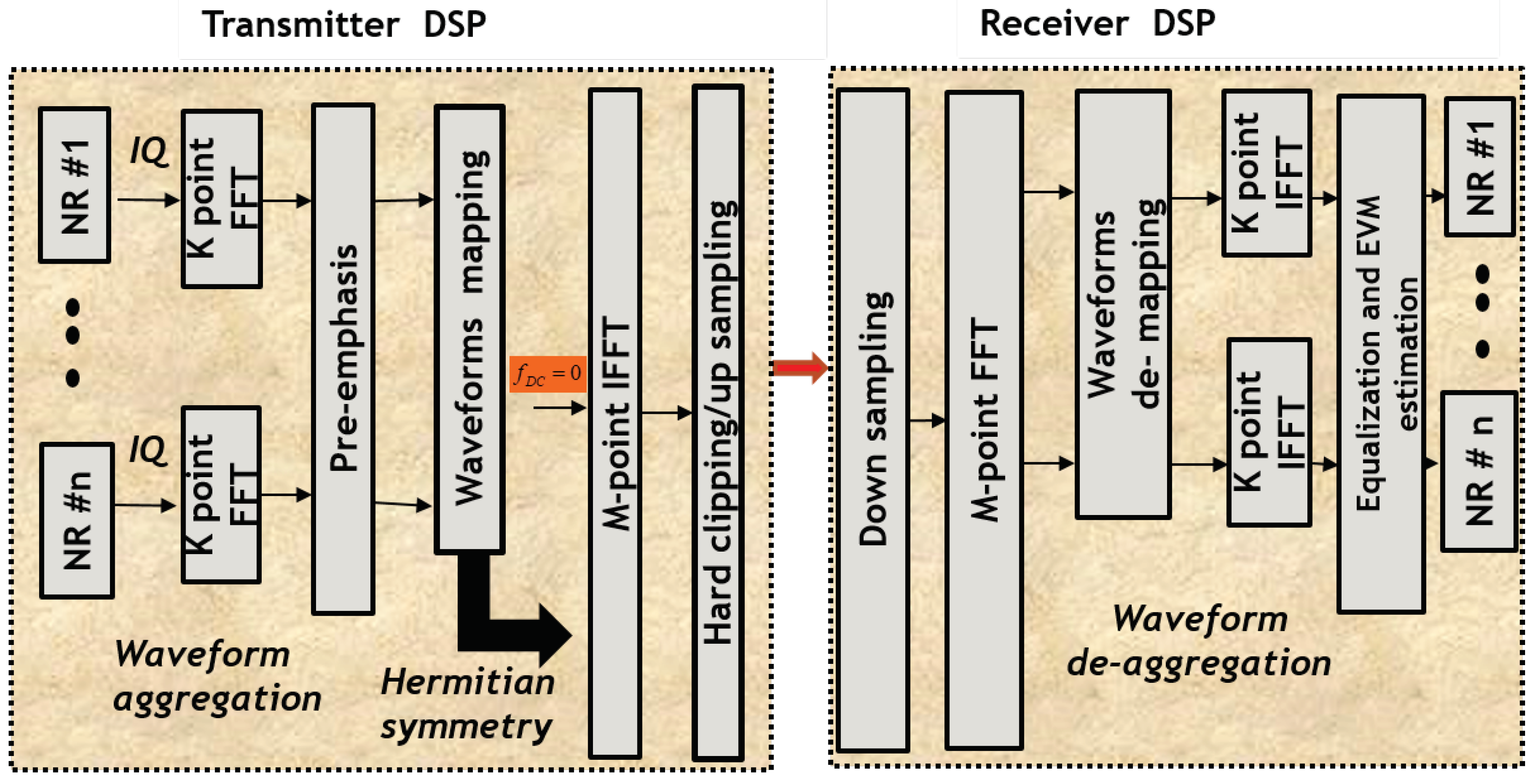


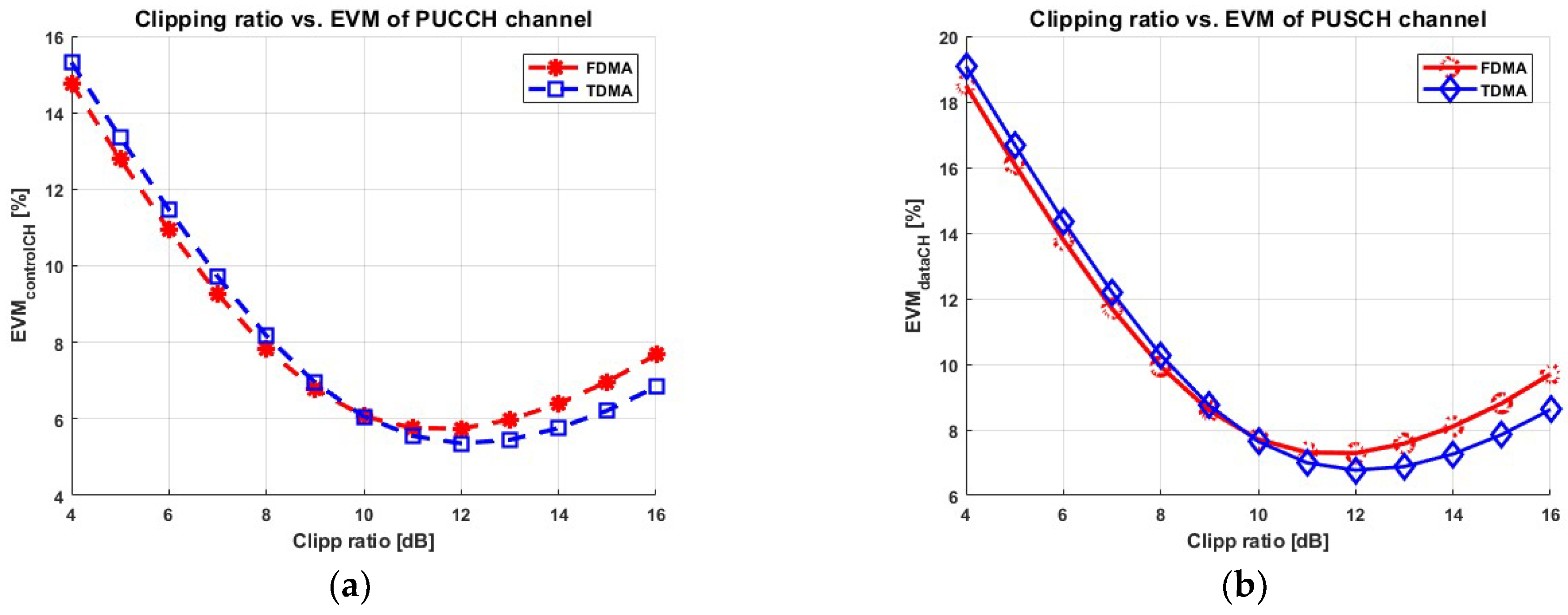
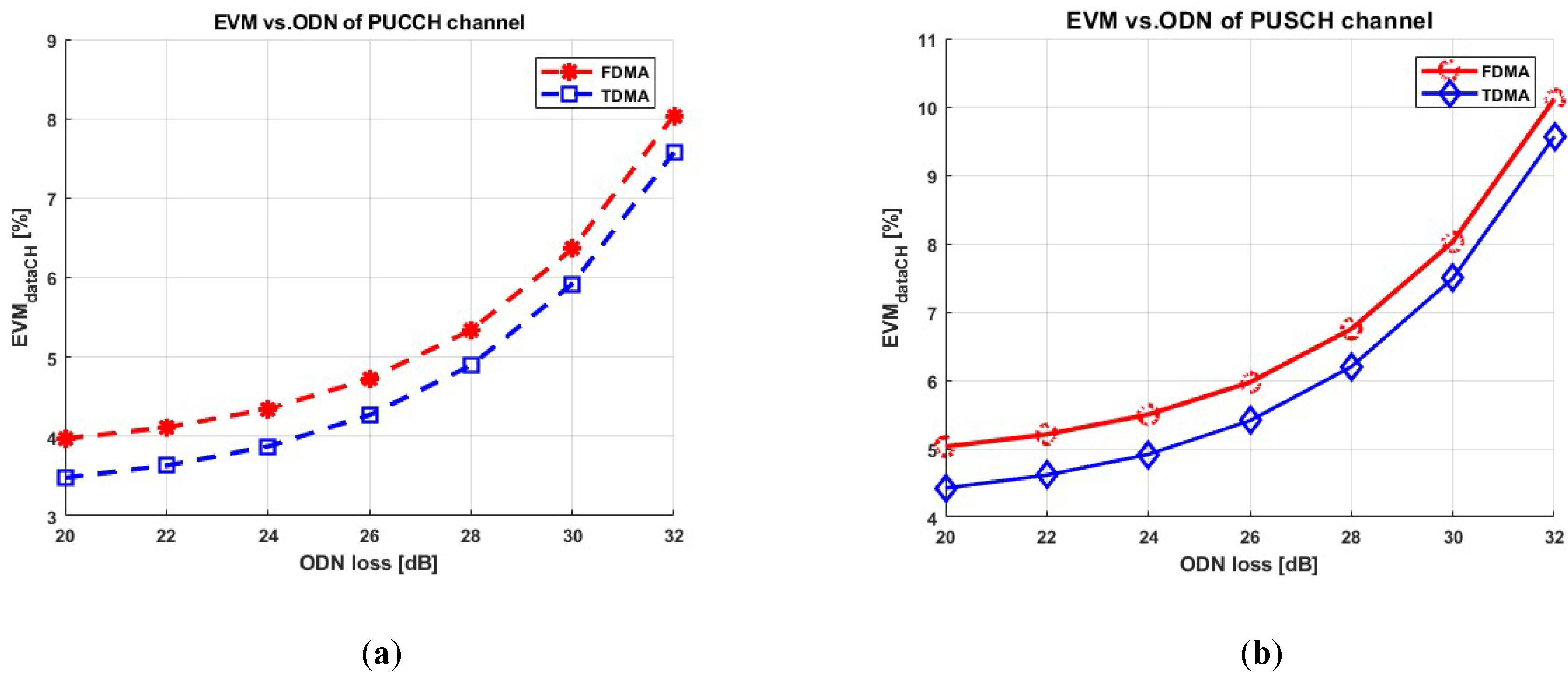




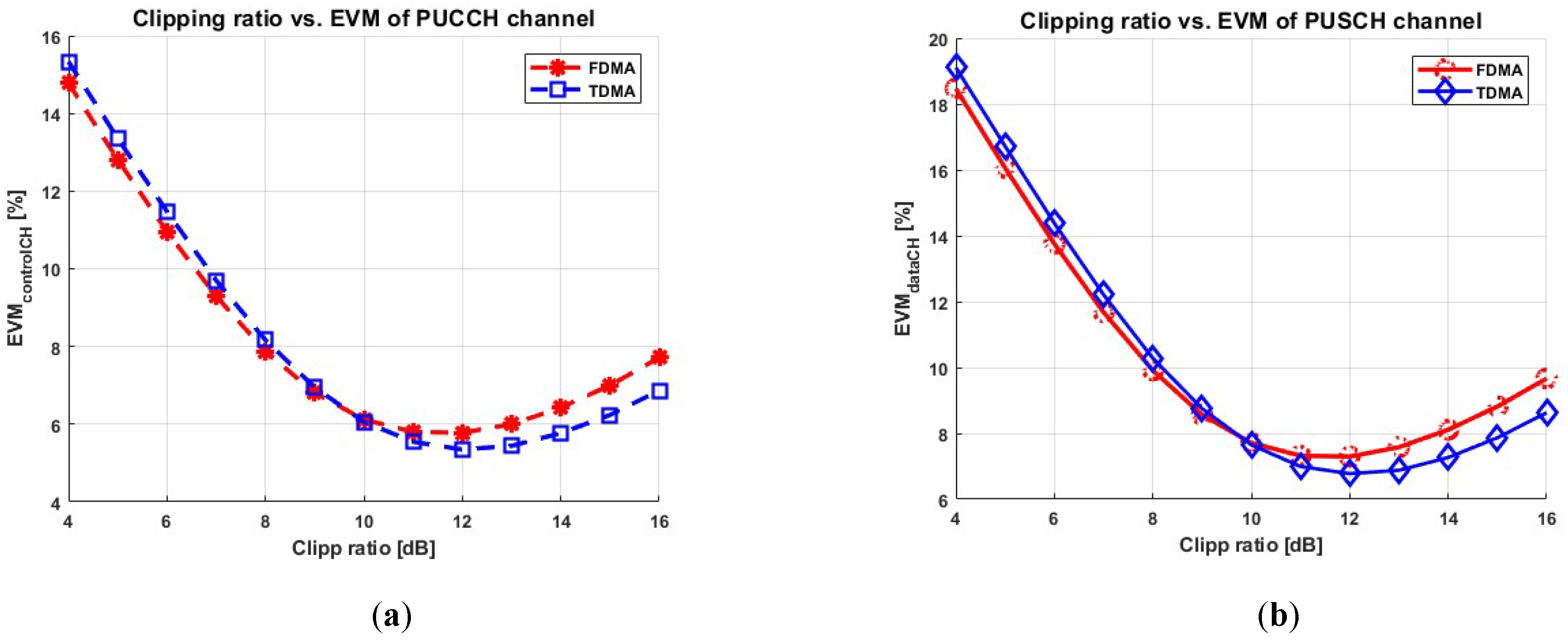
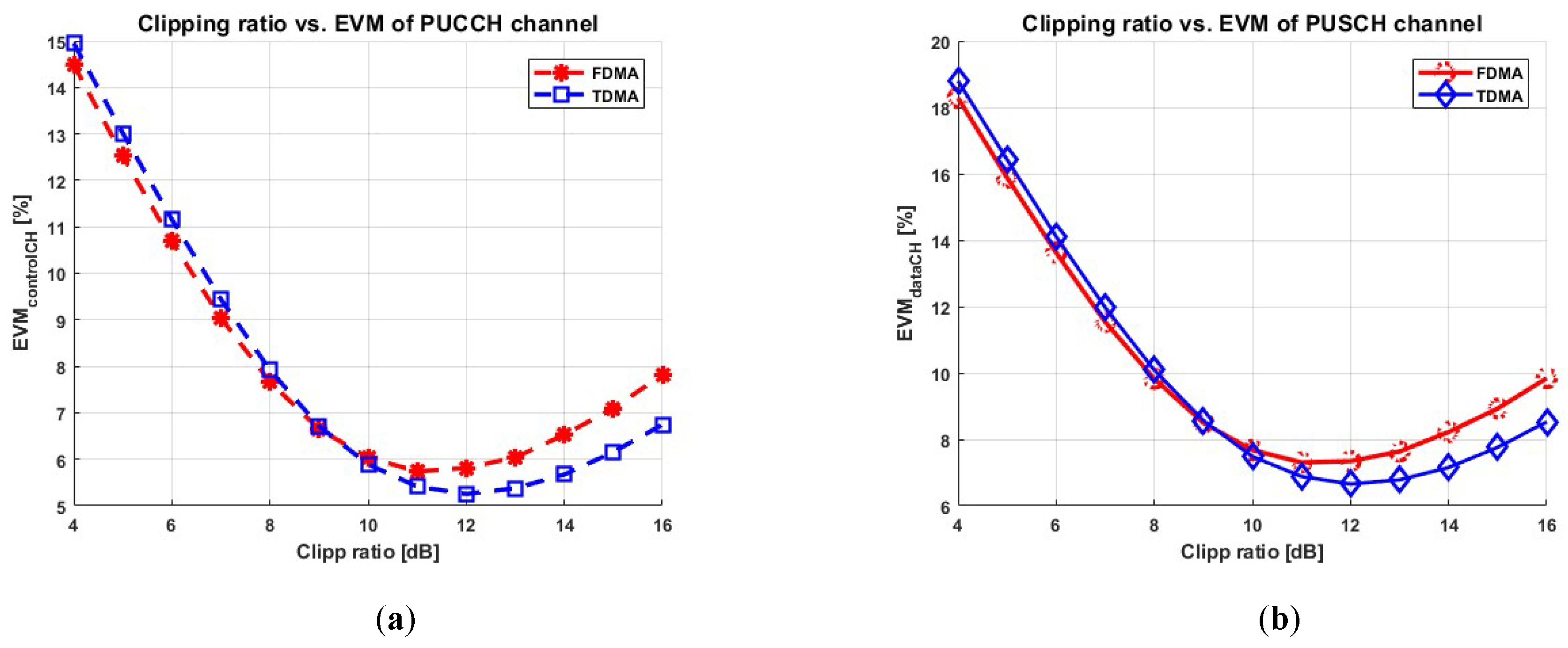


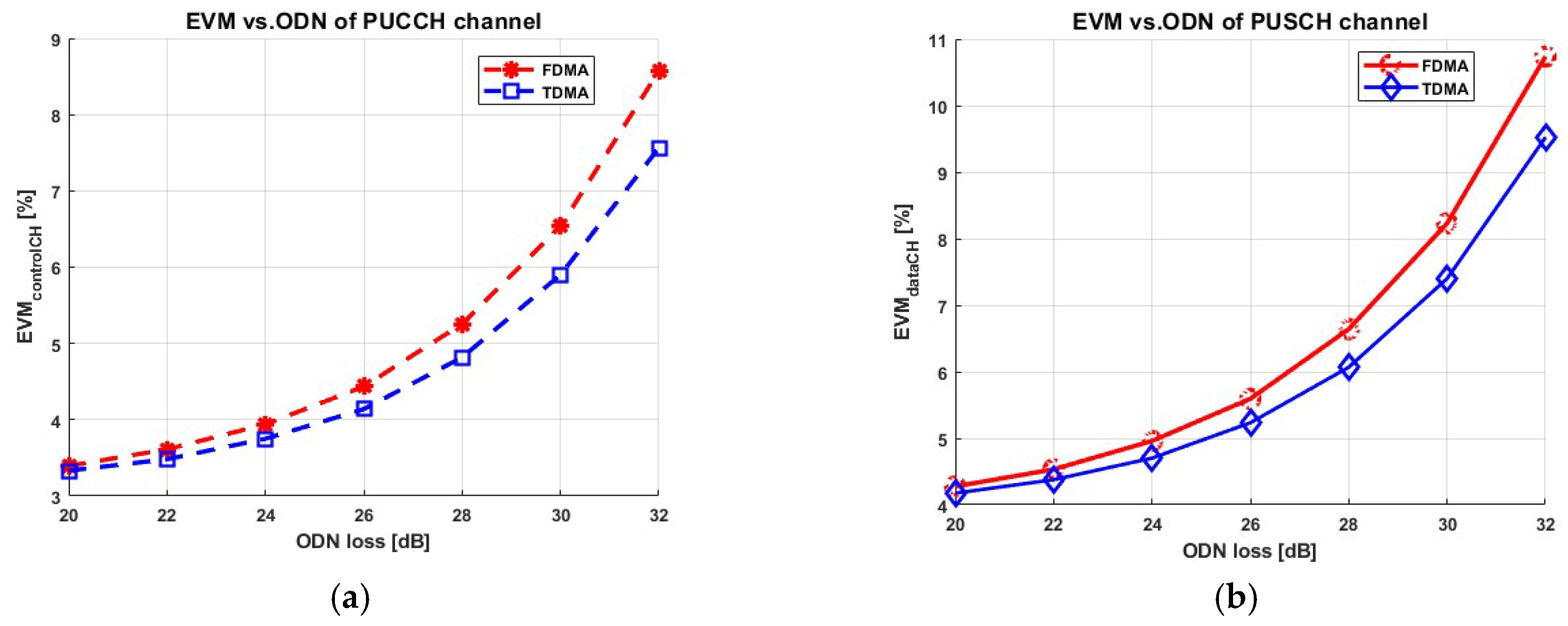
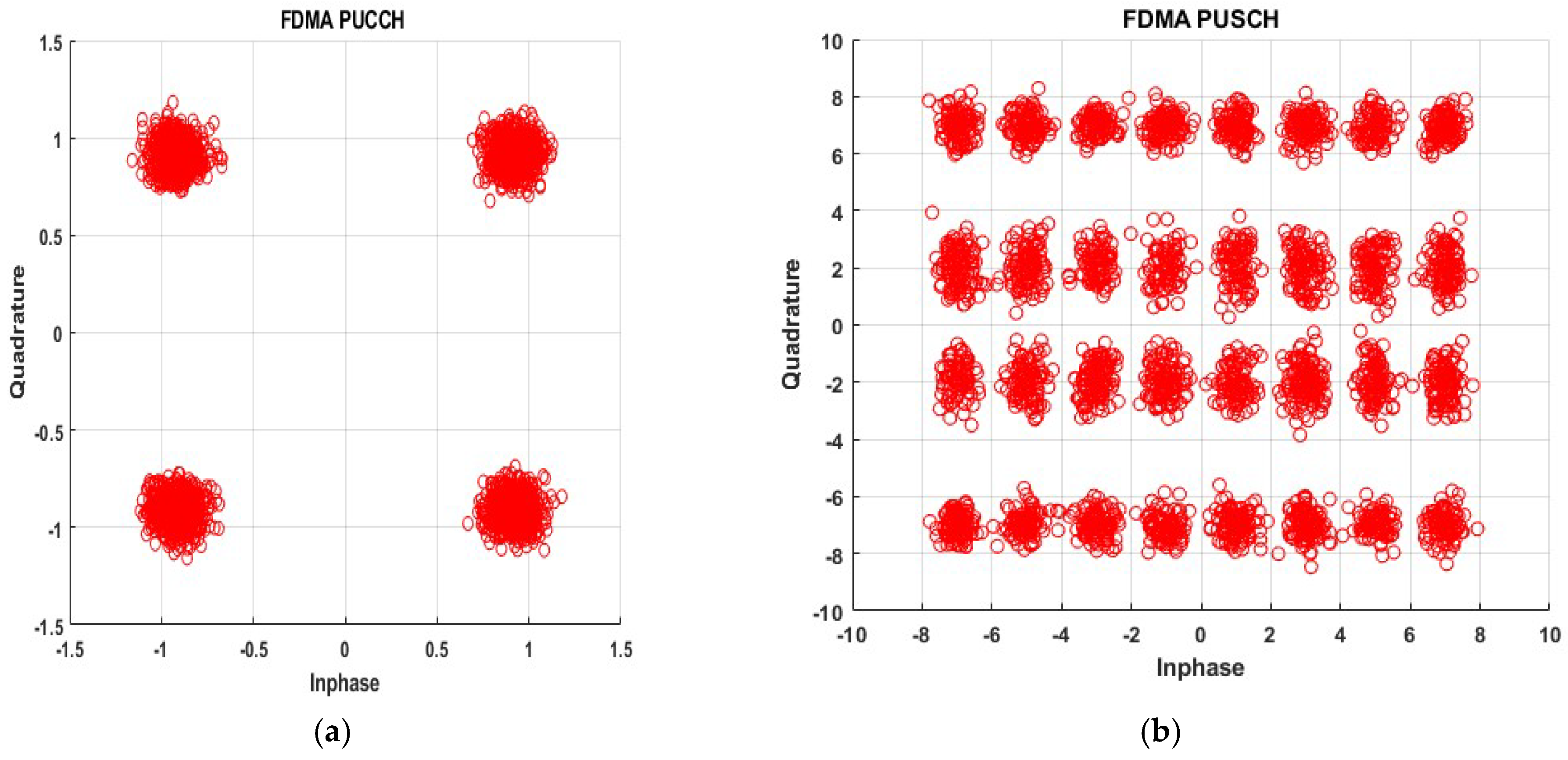
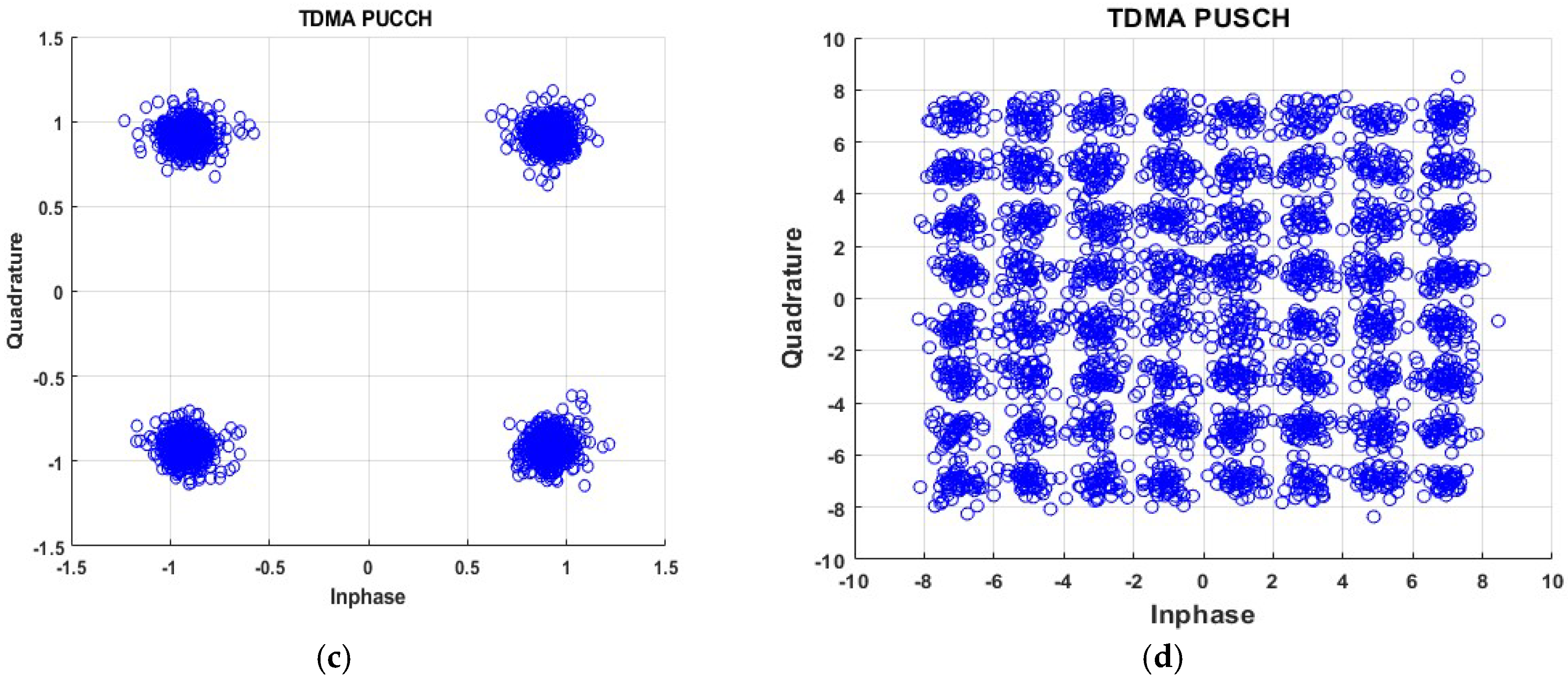
| SCs Type | SCs [KHz] | Cyclic Prefix symbols | Maximum bandwidth [MHz] | Sampling rate [MSa/s] |
|---|---|---|---|---|
| 0 | 15 | 144 | 50 | 61.44 |
| 1 | 30 | 144 | 100 | 122.88 |
| 2 | 60 | 144 | 200 | 245.76 |
| 3 | 120 | 144 | 400 | 491.52 |
| Parameters | Type 0 | Type 1 | Type 2 | Type 3 |
|---|---|---|---|---|
| n | 72 | 36 | 18 | 9 |
| BW of each NR channel (MHZ) | 50 | 100 | 200 | 400 |
| Sampling rate of each NR channel (MSa/s) | 61.44 | 122.88 | 245.76 | 491.52 |
| Total BW TDMA (GHz) | 3.6 | 3.6 | 3.6 | 3.6 |
| Total BW FDMA (GHZ) | 4.72 | 4.72 | 4.72 | 4.72 |
| BW TDMA − BW FDMA (GHz) | ~1.1 | ~1.1 | ~1.1 | ~1.1 |
| Optimum Clipping Ratio | 12 dB | 12 dB | 12 dB | 12 dB |
© 2018 by the authors. Licensee MDPI, Basel, Switzerland. This article is an open access article distributed under the terms and conditions of the Creative Commons Attribution (CC BY) license (http://creativecommons.org/licenses/by/4.0/).
Share and Cite
Mengesha, B.D.; Torres-Ferrera, P.; Gaudino, R. Analysis of 5G New Radio Uplink Signals on an Analogue-RoF System Based on DSP-Assisted Channel Aggregation. Appl. Sci. 2019, 9, 47. https://doi.org/10.3390/app9010047
Mengesha BD, Torres-Ferrera P, Gaudino R. Analysis of 5G New Radio Uplink Signals on an Analogue-RoF System Based on DSP-Assisted Channel Aggregation. Applied Sciences. 2019; 9(1):47. https://doi.org/10.3390/app9010047
Chicago/Turabian StyleMengesha, Befekadu D., Pablo Torres-Ferrera, and Roberto Gaudino. 2019. "Analysis of 5G New Radio Uplink Signals on an Analogue-RoF System Based on DSP-Assisted Channel Aggregation" Applied Sciences 9, no. 1: 47. https://doi.org/10.3390/app9010047
APA StyleMengesha, B. D., Torres-Ferrera, P., & Gaudino, R. (2019). Analysis of 5G New Radio Uplink Signals on an Analogue-RoF System Based on DSP-Assisted Channel Aggregation. Applied Sciences, 9(1), 47. https://doi.org/10.3390/app9010047





